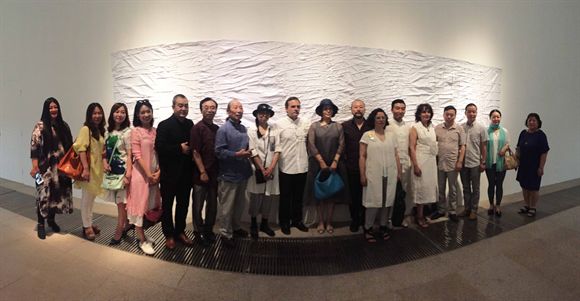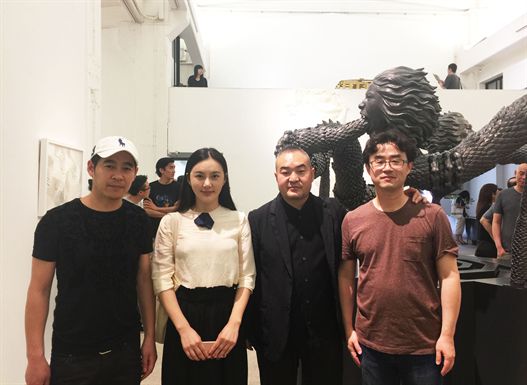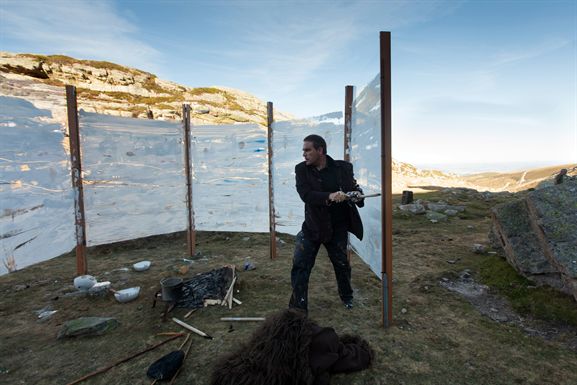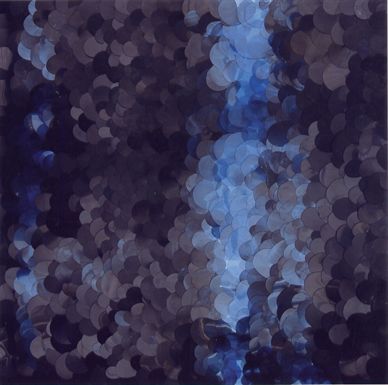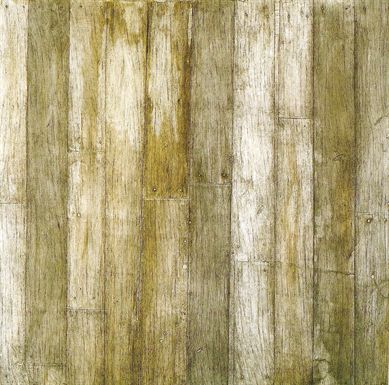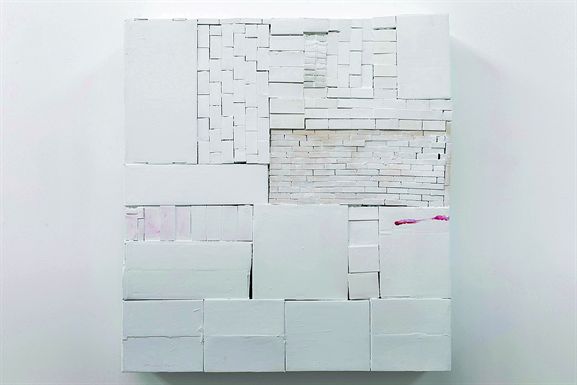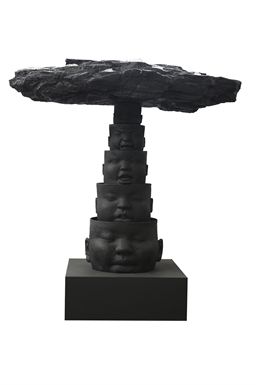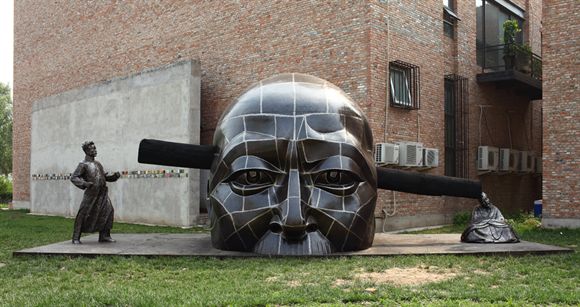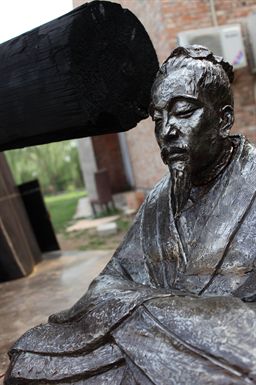Jun 12 - Jul 05, 2016
Press Release
Shamans: Cang Xin and Nacho Zubelzu
For the first time in Beijing The exhibition Shamans: Cang Xin and Nacho Zubelzu meets two leading figures of international contemporary art and shows his latest work.
AI Witchcraft (2015-2016) is the new work by Chinese artist Cang Xin (China, 1967). Over his creative career spanning more than two decades, he has been not only a witness to but also an active participant in some of the most important socio-political and cultural changes in China’s recent history. This pair of installations consists of a movable structures on which two dragons of dark silver color tail biting, one with male face and the other with female appereance. Like the sea snakes surrounding the body of Laocoon and his sons in Rome Vatican Museums, these dragons writhe in a circular motion on a square base. In the new work of Cang Xin there are several binomials, such us male-female, man-animal and man vs. machine. In the artworks of both Cang Xin and Spanish artist Nacho Zulbelzu (Spain, 1966) we find a dialogue of the opposite. The dragon is a symbol of mystery, power and ritual linked to the emperor in ancient China, which finds its echo on the surface of white dragon-flakes pattern of Transhumance (2013) by Nacho Zubelzu. The dark color in Cang Xin’s installations and the hardness of the material contrasts with the whiteness and delicacy of Zubelzu’s Woods in the snow (2016).
However, if something both artists have in common is the role they adopt to nature, they are shamans. Nacho Zubelzu intervenes in nature as an external agent according to the anthropocentric conception in Western thought, as noted in his performance Life Journey (2012). Meanwhile, Cang Xin participates in nature as an integrated element, as the Taoist thought, and as noted in some of his series of performance-photographs. In The man and the sky as one (2007), the artist lies on the rocks and the silhouette of his body merges with them, inhabiting the sublime landscape as a tiny character of the Northern Song dynasty paintings.
AI Witchcraft shows a final paradox, the complex relationship between contemporary Chinese art and Western art. This visual reference to Laocoon and his sons in the work of Cang Xin is not a mere coincidence, perhaps a reflex action. Or maybe a metaphor of the current state of contemporary art in China, always looking to the West but returning again and again to its cultural roots. As if they were the opposites attract, Cang Xin and Nacho Zubelzu show the strugle and the encounter of two artistic traditions, two dragons fighting and merging, Chinese art and Western art. Yin and yang.
The exhibition is curated by the famous Spanish curators Susana Sanz and Mónica Álvarez-Careaga. It is organized by the Art Center White Box in Beijing in cooperation with xd culture platform Beijing and it has the support of the Ministry of Culture of Spain and the Embassy of Spain in China.
Text by Susana Sanz
Curator Article
Shamans: Cang Xin and Nacho Zubelzu
by Susana Sanz
During the siege of Troy, a mysterious wooden horse was left at the gates of the mythical city. It is well known that this was a ruse devised by the ingenious Greeks to infiltrate behind the walls of their enemies. We will not waste time praising the well-know wit of Odysseus, the courage of Achilles or other legendary heroes, but the distrust of Laocoon who wanted to destroy the horse shouting: "You fools, do not rely on the Greeks even when they bring you gifts!". Laocoon is described in Virgil's Aeneid as a Trojan priest who sparked the fierce wrath of Poseidon, the god of the sea, who sent two snakes to strangle and kill him and his two children. In History of Ancient Art (1764) Winkelmann describes the Greco-Roman sculpture of Laocoon and his sons as the prototype of pain and violence in the history of Western art, but also of extraordinary beauty. This is the first of a series of paradoxes around Laocoon. In fact, the punishment of the priest was misinterpreted by the Trojans as a sign that the horse was a sacred object. It seems as if this unjust and capricious punishment was not motivated so much for trying to destroy the horse, but rather to challenge the divine and name the unnameable: a taboo.
AI Witchcraft (2015-2016) is the new work by Chinese artist Cang Xin (China, 1967), one of the leading figures of contemporary Chinese art. Throughout his more than two decades of creative career he has been not only a witness but an active protagonist of the great socio-political and cultural changes in China. This pair of installations consists of a movable structures on which two dragons of dark silver color tail biting, one with male face and the other with female appereance. Like the sea snakes surrounding the body of Laocoon and his sons in Rome Vatican Museums, these dragons writhe in a circular motion on a square base. Then paradoxes appear again, the circle described by the dragons and the square of the podium represent a complementary contradiction so often mentioned in the mythology of many different cultures, heaven and earth. Another contradiction that we see in the new work of Cang Xin is male-female, man-animal and man vs. machine binomials, which represents the engine hidden inside the structure of the installations. In the artworks of both Cang Xin and Spanish artist Nacho Zulbelzu (Spain, 1966) we find a dialogue of the opposite. The dragon with a male face recalls the horrible expression of Laocoon whose struggle with the female beast ends up merging into a violent and painful embrace. The dragon is a symbol of mystery, power and ritual linked to the emperor in ancient China, which finds its echo on the surface of white dragon-flakes pattern of Transhumance (2013) by Nacho Zubelzu. The dark color in Cang Xin’s installations and the hardness of the material contrasts with the whiteness and delicacy of Zubelzu’s Woods in the snow (2016).
However, if something both artists have in common is the role they adopt to nature, they are shamans. From the mythical collective performances that Cang Xin developed in the mid-nineties, such as Trampling Faces (1994) or To Add One Meter to an Anonymous Mountain (1995), Cang Xin does not use his own body as a canvas for his actions but as a vehicle, as a language tool, as a form of communication. It is precisely the "communication" one of the pillars of his Communications 2 series (1997) in which he photographed his performances touching with the tongue different objects of everyday life. Over the years, he developed this idea of bodily connection through his Communications 4 series (2002-2011) performing various gymnastic movements, alone or in groups, in front of monuments of China or the rest of the world; always running those exercises lying, hugging the ground and touching the ground with the tip of his tongue. Finally, this exercise of instrumentalization would focus on using his body as a means of spiritual connection with nature. Many of the critics who have approached his work refer to Cang Xin as the "shaman of Chinese contemporary art". It is undeniable that the practices of contemporary art and the deepest spiritual traditions of China are connected in his creative evolution. As a shaman, Cang Xin interprets his performances as rituals in nature, using his body as a communication element between man and sky.
As Cang Xin, Nacho Zubelzu also carries out his work of "shaman" and bridge between nature, man and art. Whether painting in gold bones, rocks or branches as in the installation Golden Cage (2016), the Spanish artist decontextualizes, transforms and "sanctifies" these pieces of nature. However, Nacho Zubelzu intervenes in nature as an external agent according to the anthropocentric conception in Western thought, as noted in his performance Life Journey (2012). Meanwhile, Cang Xin participates in nature as an integrated element, as the Taoist thought, and as noted in some of his series of performance-photographs. In The man and the sky as one (2007), the artist lies on the rocks and the silhouette of his body merges with them, inhabiting the sublime landscape as a tiny character of the Northern Song landscape paintings.
AI Witchcraft shows a final paradox, the complex relationship between contemporary Chinese art and Western art. This visual reference to Laocoon and his sons in the work of Cang Xin is not a mere coincidence, perhaps a reflex action. Or maybe a metaphor of the current state of contemporary art in China, always looking to the West but returning again and again to its cultural roots. As if they were the opposites attract, Cang Xin and Nacho Zubelzu show the strugle and the encounter of two artistic traditions, two dragons fighting and merging, Chinese art and Western art. Yin and yang.
Nacho Zubelzu. Nomadic traveler and child of Nature.
Mónica Álvarez Careaga
The notion of a white desert, a place of boundless beauty, a vast emptiness that can only be filled by an utterly free and self-sufficient human being, pervades the exhibition La memoria blanca (White Memories) (Santander, 2005), confirming the Spanish artist Nacho Zubelzu (Reinosa, Cantabria, 1966), as an expert alchemist that transmutes Nature into a panoply of meanings and appeals. This notion reappears in his project Trashumancias, displayed in Madrid, Beijing and Tokyo in 2014 and 2015. Trashumancia reveals his powerful capacity for portraying layers of meaning. The white in the little paper circles featured in this work evokes the snowflakes melting in the mountains, or the wool of sheep in search of pastures… Flowing, repetitive, continuous movements that dominate natural areas and that Zubelzu conceptualizes in his artwork.
Scratches left by a brown bear marking territory, topographic flows, or biomorphic grids feature in Nacho Zubelzu’s artwork. In his hands, the representation of leaves, trees, mountains, animals, and paths become plastic resources and the forever changing geometries of life. Zubelzu has devoted almost three decades to transform into abstract images the strength, the beauty, and the power of Nature, with the reverence and utilitarianism befitting someone who knows what Nature means to a lonely individual, unprotected before its greatness and power.
The exhibition La tinaja de Diógenes (Diogenes’ tub), (Santander 2015) focuses on a reflection about the world’s finitude and the physical and cultural context of human lives. A nomadic traveller who celebrates Nature and rural cultures in his work, Zubelzu holds the belief that art is intimately connected with life, and is based on observation, vision, empathy, memory and interpretation. In his artwork we find echoes of philosophy, anthropology and archeology. His vision could be described as culturalist, in that he seeks to capture the essence of what is human, a purpose originating in his early interest in the distinctive features of other nations and in traditional trades. His enjoyment of the manual aspects of creative work and his close relationship with the physical construction of the artwork are key drivers of his artistic explorations.
Nacho Zubelzu’s artwork is extremely varied, and ultimate results depend on the varying intentions pursued. His range of themes is wide, from autobiographic memories linked to rural life in Campoo (Cantabria, Spain), his homeland, to hermetic creations in which figurative elements are used as abstract symbols. Using some of the techniques and mediums characteristic for Zubelzu, such as pen-style drawings, acrylic painting on acetate, polyester resin sculptures, sewn textiles, videos and installations, he plastically and spatially interprets the importance of material life and the sacred value of work.
Zubelzu internalizes various popular narratives from Europe and Africa in order to create a personal shamanic world, a world of images, not objects, which always refers to the poetic status of things, the contrasts between light and darkness. In his paintings, the images appear in an inverse way, from behind transparent methacrylate, emphasizing the magic of creation, where the ideas of discovery and revelation mediate.
His works aim at surprising the viewer, contradicting his tendency to interpret art in a conventional way. They function through the fascination of an immediate presence, using the power of surprise and mystery. The pleasure of creation itself -subversive, strange, destabilizing, and lacking practical functionality- results in a poetic type of work that strives to convey the ontological knowledge that Zubelzu tackles with independence and passion.

